February 11, 1999
Game Four
White: Ty Davison
Black: Allen Starfy
Opening: C45 Scotch Game, Mieses V
E-mail, Game 4, 1997
Al: My intention from the outset was not to try to win (although if the opportunity arose...) but to try to close up the game as much as possible and then later play for a draw or at least get in a position for stalemate. Unfortunately, I was not able to close up the positions and ended up with no real strategy except to react to White's moves. I was not happy with this game at all. It seemed straight forward, and, to my mind, had no aesthetic quality to it whatsoever (something I really look for in a game). I think I made 2 "nice" moves in the entire game.
1. e4 e5
2. Nf3 Nc6
3. d4 exd4
Ty: I believe I'll have a Scotch.
4. Nxd4 Nf6
5. Nxc6
Ty: Also interesting is 5. Bg5 which pins the Knight. I went with 5. Nxc6 is because it will disrupt Al's pawn structure, and I know from experience that will be crucial in my attempt to win. (Note also that Black will now be castling Kingside.)
5. ... bxc6
Al: Typical developing moves for this type of game.
6. e5 Nd5
7. c4 Nb4
Ty: I think 7. ... Nb6 is better here if only because it will allow a move for Black to develop. (Since 8. c5 leads to 8. ... Bxc5.)
Al: I think you are right about ...Nb6. Although the point of my "dancing" Knight was to disrupt your pawn structure and, hopefully, allow me to close up the position.
8. a3 Na6
9. b4
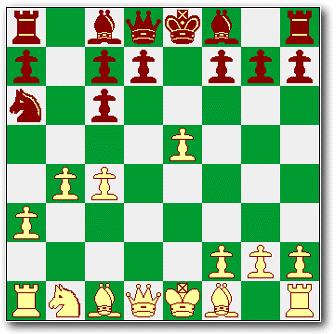
Ty: Up to this point I've forced Al's Knight around the board while advancing my pawns. Notice how the a3 and b4 pawn keep the Knight "locked up" to a certain extent.
9. ... Be7
10. Bd3 d6
11. Bf4 O-O
12. O-O f6
Al: Most likely unsound but felt it a necessary "evil" at the time.
Ty: This was quite unexpected, and long-term I'm not convinced it's very sound because of the damage it does to the King's pawn wall. Short-term, of course, it's a pain in the butt for White.
13. Qc2
Ty: It probably won't succeed as a mating attack, but this at least gives me the potential of a couple different ways at checkmate if Black messes up.
13. ... fxe5
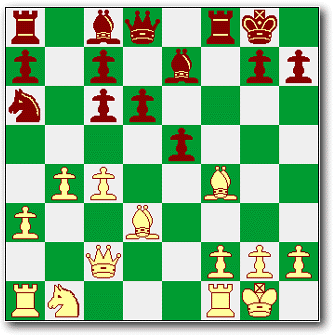
Ty: With White's Queen and Bishop pointed at pawn h7, I think the best move here is advancing the f-pawn to f5. It utterly frustrates White's kingside attack by closing down the b1-h7 diagonal and makes for a much more closed game.
14. Bxh7+ Kh8
15. Be3 g6
Al: One of only a couple of moves that I really liked, and one that I gave a great deal of thought.
Ty: The unenlightened observer will look at 15. ... g6 and just say, "Why, he's just given the pawn away. What a silly move." In truth, it's a daring trap. If I take with my Queen to try to press the advantage on Black's King (16. Qxg6), then Black plays 16. ... Bf5 and White's out the h7 Bishop.
16. Bxg6 Rg8
17. Be4 d5
18. cxd5 cxd5
19. Qc6!
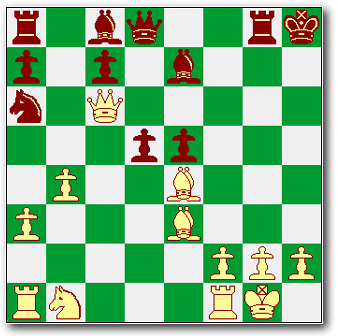
Ty: Black can play 19. ... dxe4, but it'll cost a Rook.
Al: A move I thought bold and, I must admit, I didn't consider at the time.
19. ... Bg5
Ty: Because the e3 Bishop is protected by the f2 pawn, I don't follow this attacking strategy. I can't find a substantial threat to White. I prefer taking the central Bishop in trade for the a8 Rook, though I do concede this is a question of which move is the "least worst."
UPDATE: Okay, I'm an idiot. 19. ... Bg5 is, in fact, an absolutely essential move since the threat of 20. Qh6++ looms large. Amazing that I didn't see it at the time.
20. Bxd5 Rb8
21. Bxg8 Qxg8
22. Bxg5
Ty: Note the free pawn on a7. I actively considered taking it before I discovered that Black had a pretty potent remedy in 22. Bb7. I'd be forced to move off my Queen, Black plays 23. ... Bxe3 and if I play anything other than 24. g3, Black checkmates in the next move. (Even if I play 24. g3, I still lose the e3 Bishop with no compensation.) So I traded Bishops instead.
22. ... Qxg5
23. f3
Ty: This my defense against Black's Bishop b7 attack I mentioned. Now at least I won't be checkmated right away.
Al: Darn, and after all that trouble too.
23. ... Bb7
Ty: Black fianchettos his Bishop which gives him the run of the tasty long diagonal.
24. Qc3 Rf8
Ty: I don't see a good attack against the f3 pawn unless White messes up. I like better 24. ... Rg8 which doubles on the g-file, though I'm not certain it's an ultimately winning strategy either.
25. Nd2 Rd8
26. R(a)d1 c5
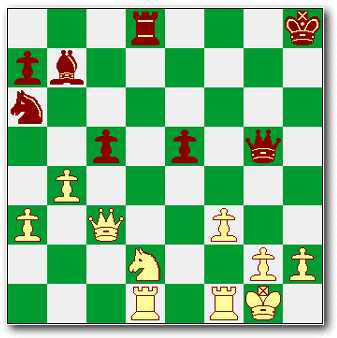
Ty: There's a revealed attack coming from the Rook behind the Knight on the d-file, making c5 unrewarding as a move. Though it only amounts to a trade of Rooks if played correctly by Black, trades should be all that White needs at this point to win the game.
27. Ne4 Qe7
28. Rxd8+ Qxd8
29. Qxe5+ Kg8
30. Nxc5 Qd5
Ty: An interesting idea to trade out Queens here. Personally, I would've taken the Knight with 30. ... Nxc5. With the a- and b-file pawns where they are, the Knight has been functionally useless anyway and in endgameville, Knights are pretty much low man on the totem pole. Having said that, a case can definitely be made that a Queen trade, though leaving a tough end game, would've benefitted Black more than White.
Al: Yes, I think you're correct about ...Nxc5, although at this point Black is basically locked-up and it's easy to see the proverbial "handwriting on the wall."
31. Qe8+ Kh7
32. Nxb7 Qxb7
Ty: By checking the King, I gain the initiative I need to decide which piece, Knight or Bishop, I want to take. With the Knight still somewhat "locked up" by the pawns and the Bishop on the long diagonal, Bishop it is.
33. Re1 Qb6+
34. Kf1
Ty: Definitely not 34. Kh1 which could lead to checkmate if I screw up in attacking the Black King.
34. ... Kg7
Ty: I think 34. ...Nc7 might have complicated the mate for White a little bit more, but frankly, I don't see any way out. White mates in 6.
35. Qe7+ Kg8
36. Qe8+ Kg7
37. Re7+ Kf6
38. Qf7+ 1-0. Black resigns.
Al: This I considered my second best move of the game. ;-)
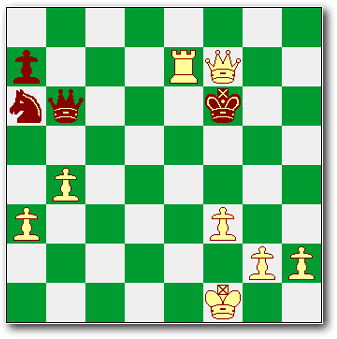
Ty: A pretty good game, though as Al noted lacking in aesthetic brilliance. At the same time, it definitely helped that the game was of the more open style that I prefer. Black's more conservative strategy, while fairly well executed, probably would've achieved better results if the game were played with a more closed opening like the Caro-Kann.
|





